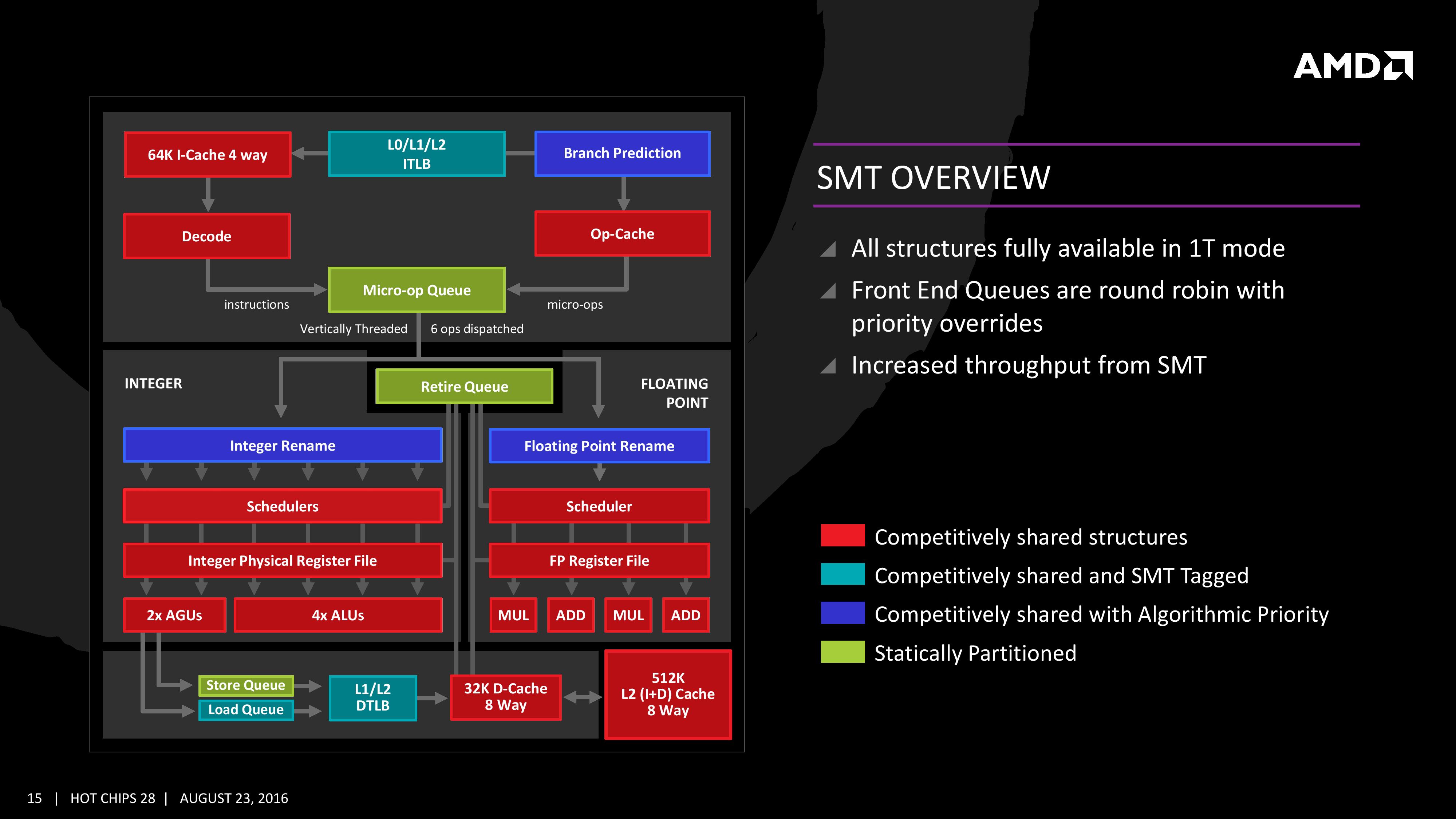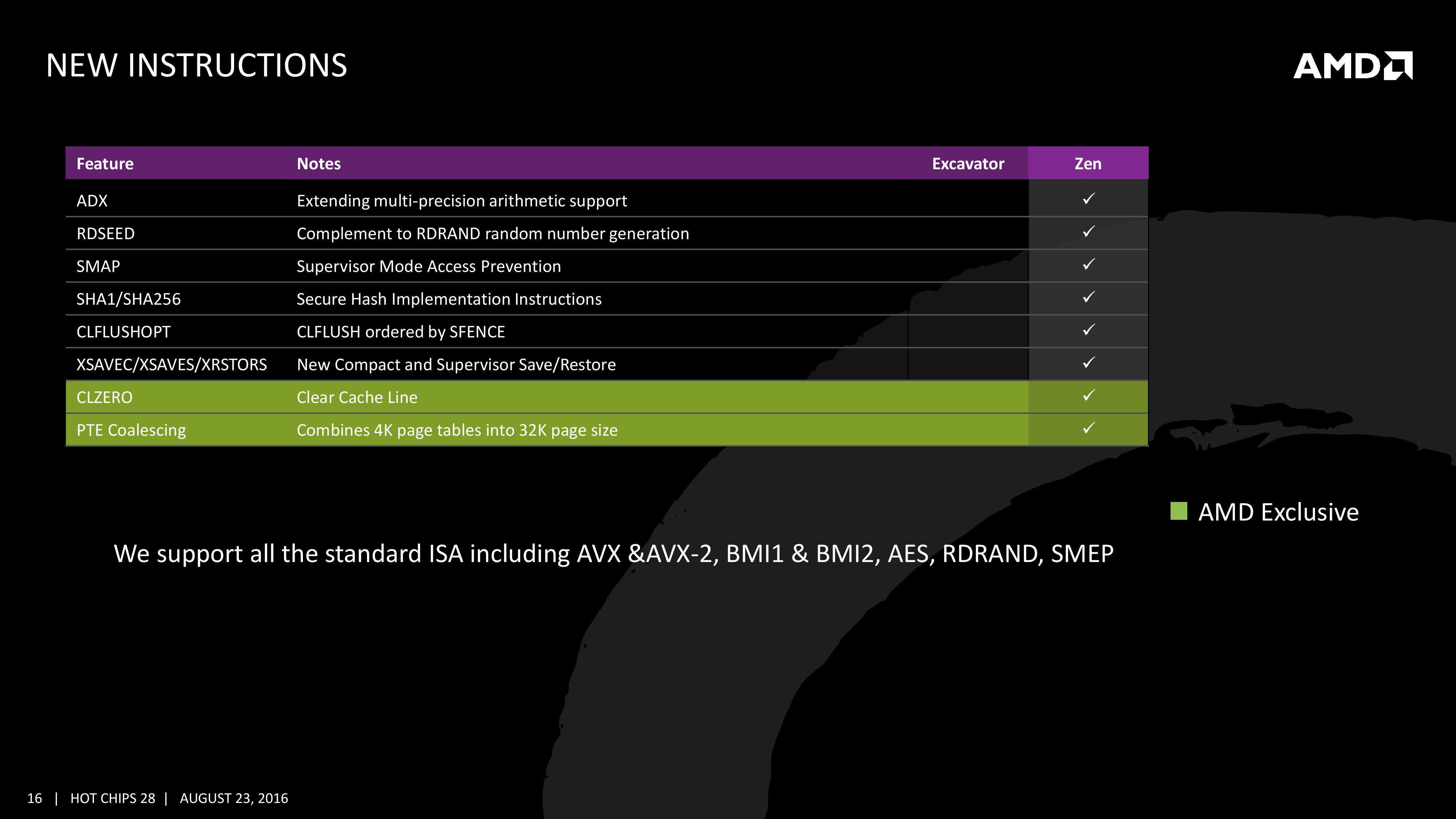The AMD Zen and Ryzen 7 Review: A Deep Dive on 1800X, 1700X and 1700
by Ian Cutress on March 2, 2017 9:00 AM ESTSimultaneous MultiThreading (SMT)
Zen will be AMD’s first foray into a true simultaneous multithreading structure, and certain parts of the core will act differently depending on their implementation. There are many ways to manage threads, particularly to avoid stalls where one thread is blocking another that ends in the system hanging or crashing. The drivers that communicate with the OS also have to make sure they can distinguish between threads running on new cores or when a core is already occupied – to achieve maximum throughput then four threads should be across two cores, but for efficiency where speed isn’t a factor, perhaps power gating/clock gating half the cores in a CCX is a good idea.
There are a number of ways that AMD will deal with thread management. The basic way is time slicing, and giving each thread an equal share of the pie. This is not always the best policy, especially when you have one performance dominant thread, or one thread that creates a lot of stalls, or a thread where latency is vital. In some methodologies the importance of a thread can be tagged or determined, and this is what we get here, though for some of the structures in the core it has to revert to a basic model.
With each thread, AMD performs internal analysis on the data stream for each to see which thread has algorithmic priority. This means that certain threads will require more resources, or that a branch miss needs to be prioritized to avoid long stall delays. The elements in blue (Branch Prediction, INT/FP Rename) operate on this methodology.
A thread can also be tagged with higher priority. This is important for latency sensitive operations, such as a touch-screen input or immediate user input elements required. The Translation Lookaside Buffers work in this way, to prioritize looking for recent virtual memory address translations. The Load Queue is similarly enabled this way, as typically low latency workloads require data as soon as possible, so the load queue is perfect for this.
Certain parts of the core are statically partitioned, giving each thread an equal timing. This is implemented mostly for anything that is typically processed in-order, such as anything coming out of the micro-op queue, the retire queue and the store queue. However, when running in SMT mode but only with a single thread, the statically partitioned parts of the core can end up as a bottleneck, as they are idle half the time.
The rest of the core is done via competitive scheduling, meaning that if a thread demands more resources it will try to get there first if there is space to do so each cycle.
New Instructions
AMD has a couple of tricks up its sleeve for Zen. Along with including the standard ISA, there are a few new custom instructions that are AMD only.
Some of the new commands are linked with ones that Intel already uses, such as RDSEED for random number generation, or SHA1/SHA256 for cryptography (even with the recent breakthrough in security). The two new instructions are CLZERO and PTE Coalescing.
The first, CLZERO, is aimed to clear a cache line and is more aimed at the data center and HPC crowds. This allows a thread to clear a poisoned cache line atomically (in one cycle) in preparation for zero data structures. It also allows a level of repeatability when the cache line is filled with expected data. CLZERO support will be determined by a CPUID bit.
PTE (Page Table Entry) Coalescing is the ability to combine small 4K page tables into 32K page tables, and is a software transparent implementation. This is useful for reducing the number of entries in the TLBs and the queues, but requires certain criteria of the data to be used within the branch predictor to be met.












574 Comments
View All Comments
Notmyusualid - Saturday, March 4, 2017 - link
Can't disagree with you pal. They look like they execptional value for money.I on the other hand, am already on LGA2011-v3 platform, so I won't be changing, but the main point here is - AMD are back. And we welcome them too.
Alexvrb - Saturday, March 4, 2017 - link
Yeah... if the pricing is as good as rumored for the Ryzen 5, I may pick up a quad-core model. Gives me an upgrade path too, maybe a Ryzen+ hexa or octa-core down the road. For budget builds that Ryzen 3 non-SMT quad-core is going to be hard to argue with though.wut - Sunday, March 5, 2017 - link
You're really optimistically assuming things.Kaby Lake Core i5 7400 $170
Ryzen 5 1600X $259
...and single thread benchmark shows Core i5 to be firmly ahead, just as Core i7 is. The story doesn't seem to change much in the mid range.
Meteor2 - Tuesday, March 7, 2017 - link
@wut spot-on. It also seems that Zen on GloFlo 14 nm doesn't clock higher than 4.0 GHz. Zen has lower IPC and lower actual clocks than Intel KBL.Whichever way you cut it, however many cores in a chip are being considered, in terms of performance, Intel leads. Intel's pricing on >4 core parts is stupid and AMD gives them worthy price competition here. But at 4C and below, Intel still leads. AMD isn't price-competitive here either. No wonder Intel haven't responded to Zen. A small clock bump with Coffee Lake and a slow move to 10 nm starting with Cannon Lake for mobile CPUs (alongside or behind the introduction of 10 nm 'datacentre' chips) is all they need to do over the next year.
After all, if Intel used the same logic as TSMC and GloFlo in naming their process nodes, i.e. using the equivalent nanometre number of if finFETs weren't being used, Intel would say they're on a 10 nm process. They have a clear lead over GloFlo and thus anything AMD can do.
Cooe - Sunday, February 28, 2021 - link
I'm here from the future to tell you that you were wrong about literally everything though. AMD is kicking Intel's ass up and down the block with no end in sight.Cooe - Sunday, February 28, 2021 - link
Hahahaha. I really fucking hope nobody actually took your "buying advice". The 6-core/12-thread Ryzen 5 1600 was about as fast at 1080p gaming as the 4c/4t i5-7400 ON RELEASE in 2017, and nowadays with modern games/engines it's like TWICE AS FAST.deltaFx2 - Saturday, March 4, 2017 - link
I think the reviewer you're quoting is Gamers Nexus. He doesn't come across as being a particularly erudite person on matters of computer architecture. He throws a bunch of tests at it, and then spews a few untutored opinions, which may or may not be true. Tom's hardware does a lot of the same thing, and more, and their opinions are far more nuanced. Although they too could have tried to use an AMD graphics card to see if the problems persist there as well, but perhaps time was the constraint.There's the other question of whether running the most expensive GPU at 1080p is representative of real-world performance. Gaming, after all, is visual and largely subjective. Will you notice a drop of (say) 10 FPS at 150 FPS? How do you measure goodness of output? Let's contrive something.
All CPUs have bottlenecks, including Intel. The cases where AMD does better than Intel are where AMD doesn't have the bottlenecks Intel has, but nobody has noticed it before because there wasn't anything else to stack up against it. The question that needs to be answered in the following weeks and months is, are AMD's bottlenecks fixable with (say) a compiler tweak or library change? I'd expect much of it is, but lets see. There was a comment on some forum (can't remember) that said that back when Athlon64 (K8) came out, the gaming community was certain that it was terrible for gaming, and Netburst was the way to go. That opinion changed pretty quickly.
Notmyusualid - Saturday, March 4, 2017 - link
Gamers Nexus seem 'OK' to me. I don't know the site like I do Anandtech, but since Anand missed out the games....I am forced to make my opinions elsewhere. And funny you mentions Toms, they seem to back it up to some degree too, and I know these two sites are cross-owned.
But still, when Anand get around to benching games with Ryzen, only then will I draw my final conclusions.
deltaFx2 - Sunday, March 5, 2017 - link
@ Notmyusualid: I'm sure Gamers Nexus numbers are reasonable. I think they and Tom's (and other reviewers) see a valid bottleneck that I can only guess is software optimization related. The issue with GN was the bizarre and uninformed editorializing. Comments like, the workloads that AMD does well at are not important because they can be accelerated on GPU (not true, but if true, why on earth did GN use it in the first place?). There are other cases where he drops i5s from evaluation for "methodological reasons" but then says R7 == i5. Even based on the tests he ran, this is not true. Anyway, the reddit link goes over this in far more detail than I could (or would).Meteor2 - Tuesday, March 7, 2017 - link
@DeltaFX2 in what way was GamersNexus conclusion that tasks that can be pushed to GPUs should be incorrect? Are you saying Premiere and Blender can't be used on GPUs?GN's conclusion was:
"If you’re doing something truly software accelerated and cannot push to the GPU, then AMD is better at the price versus its Intel competition. AMD has done well with its 1800X strictly in this regard. You’ll just have to determine if you ever use software rendering, considering the workhorse that a modern GPU is when OpenCL/CUDA are present. If you know specific in stances where CPU acceleration is beneficial to your workflow or pipeline, consider the 1800X."
I think that's very fair and a very good summary of Ryzen.